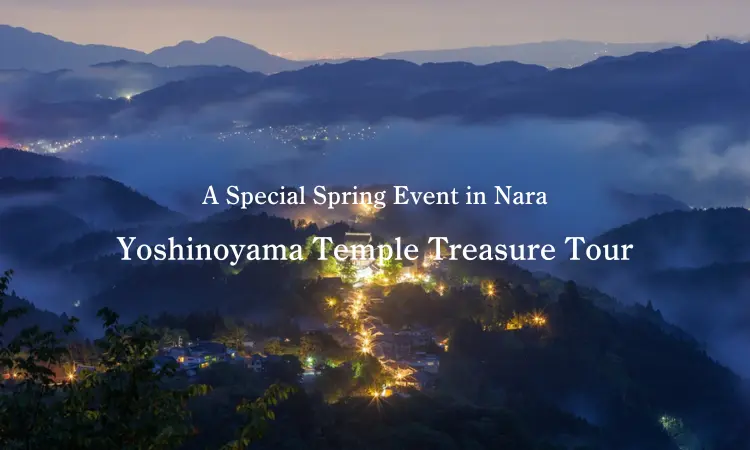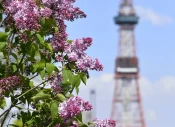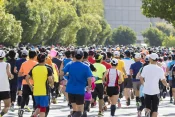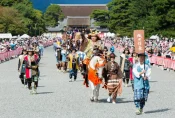Yoshinoyama Temple Treasure Tour: A Special Spring Event in Nara
The Yoshinoyama Temple Treasure Tour is a rare event where nine temples in Yoshinoyama open their doors to display sacred statues and cultural treasures that are typically hidden from public view. Visitors can experience Japan’s deep spiritual heritage while exploring these treasures, and also collect commemorative items like “sange” petals and goshuincho (temple seal books). The event will run from March 1, 2024, to March 31, 2025, covering the entire Yoshinoyama area.
Event Overview
- Period: March 1, 2024, to March 31, 2025.
- Venue: The entire Yoshinoyama area will serve as the grand venue for this extraordinary event.
- Purpose: To give the public access to sacred statues and treasures that are normally kept hidden from view, offering a rare insight into the spiritual and cultural significance of Yoshinoyama’s temples.
- Experience: Visitors are encouraged to explore the different temples and enjoy viewing the rare treasures displayed at each site. This experience will provide a deeper understanding of Yoshinoyama’s rich cultural history and its significance within Japan’s religious landscape.
Participating Temples
- Kimpusen-ji: The main training center of Shugendo mountain asceticism and home to the National Treasure main hall, Zaodo, a striking structure that embodies the spiritual significance of the region.
- Kizoin: Known for its statues of En no Gyoja, the founder of Shugendo, and a striking statue of a tengu (goblin-like creature), which captures the mythical essence of mountain spirituality.
- Tonan-in: Dedicated to Dainichi Nyorai, this temple is designated as a prefectural cultural property and offers visitors a profound sense of peace and connection to Buddhist tradition.
- Nyoirin-ji: This temple houses the tomb of Emperor Go-Daigo and also holds important cultural artifacts, providing a rare glimpse into the imperial past of Japan and its connection to the Buddhist faith.
- Dainichi-ji: Famous for displaying the “Twenty-Five Bodhisattvas Descent of Amida” artwork, this temple is a must-visit for those interested in Buddhist art and its portrayal of enlightenment and compassion.
- Kogen-ji: Home to a standing wooden statue of Amida Nyorai, which has been designated as a prefectural cultural property. The intricacy of the statue’s craftsmanship leaves a lasting impression on visitors.
- Zenpuku-ji: This temple enshrines the Kaki-no-Ha Yakushi Buddha, a unique manifestation of Yakushi Nyorai, who is revered as the healing Buddha.
- Chikurin-in: Displays a seated statue of Prince Shotoku, a key figure in Japan’s early adoption of Buddhism, whose contributions to Japanese culture and governance are remembered fondly.
- Sakura Motobo: Enshrines Jinben Daibosatsu, a deity who symbolizes the mountain’s divine energy, highlighting the deep spiritual roots of the region.
Specially Displayed Treasures
- Kimpusen-ji: Statues of Ananda and Kasho, two of the Buddha’s most devoted disciples. These statues stand as symbols of dedication and spiritual pursuit, offering insight into the Buddhist monastic life.
- Dainichi-ji: A beautifully detailed folding screen depicting the “Twenty-Five Bodhisattvas Descent of Amida,” illustrating the path of enlightenment and the role of the Bodhisattvas in guiding souls.
- Chikurin-in: Seated statue of Prince Shotoku, whose dedication to Buddhism helped shape Japanese culture.
- Tonan-in: Statues of En no Gyoja and Zenki/Goki, figures that play a critical role in the mythology of Shugendo and mountain ascetic practices.
- Kizoin: The large standing statue of Ominesan Great Tengu is particularly striking, showcasing the mystical and protective nature of these legendary creatures.
- Kogen-ji: The statue of Kokuzo Bosatsu, known for granting wisdom, reflects the importance placed on knowledge and spiritual growth.
- Zenpuku-ji: Statue of Kaki-no-Ha Yakushi Buddha, which has become a symbol of healing and faith for those who visit.
- Sakura Motobo: Statue of En no Gyoja’s mother, an important figure that embodies the deep connection between familial love and spiritual dedication.
- Nyoirin-ji: The painting “Battle of Shijo-Nawate” by Utagawa Kuniyoshi, a renowned ukiyo-e artist, adds a historical layer to the temple’s treasures, showcasing Japan’s cultural and artistic heritage.
Commemorative Seals and Souvenirs
- Commemorative Sange Petals: Available for 100 yen each, these petals are not only a beautiful reminder of your visit but also symbolize the impermanence of life, a key teaching in Buddhism.
- Goshuincho (Temple Seal Book): Available for 600 yen each, these books are cherished by many visitors as they provide a place to collect unique stamps from each temple visited, making for a meaningful keepsake.
- Goshuin (Temple Seals): Offered at each temple for 500 yen, these seals are hand-stamped and often include beautiful calligraphy that represents the temple. Collecting goshuin is a popular way to commemorate one’s journey through the temples.
These souvenirs offer visitors a way to enrich their experience by collecting unique mementos from each temple they visit. The goshuincho and sange petals are especially popular, not just as collectibles, but as symbols of the journey and the spiritual encounters along the way.
Access Information
- Location: Yoshinoyama, Yoshino-cho, Yoshino District, 639-3115. The area is known for its stunning views, especially in spring, when cherry blossoms blanket the mountainsides, adding to the spiritual ambiance of the tour.
- Nearest Station: Kintetsu Yoshino Station provides easy access to the region, with connections available via the Yoshino Ropeway, which offers breathtaking views of the valley as you ascend into the heart of Yoshinoyama.
- Ropeway: The ropeway’s operation schedule varies depending on the season, so be sure to check the latest information in advance to avoid inconvenience. It is a beautiful way to start or end your temple visit, providing panoramic views of Yoshino’s natural beauty.
- Parking: Parking facilities are available throughout the Yoshinoyama area, which is especially convenient for those traveling by car. Given the popularity of the event, visitors are encouraged to arrive early to secure a spot.
For more detailed access information and updates on seasonal operations, please visit the Yoshino Omine Cable Car Company website. Their site provides useful tips for travelers, including the best times to visit, ropeway schedules, and any changes to local transportation.
The Yoshinoyama Temple Treasure Tour is an immersive cultural and spiritual experience that allows visitors to connect deeply with the history and natural beauty of Nara. Whether you are a history enthusiast, a lover of traditional Japanese culture, or simply someone looking to experience the serene beauty of temple life, this event provides a perfect opportunity. Come and experience the magic of Yoshinoyama, and let the tranquility of this sacred mountain rejuvenate your spirit.









